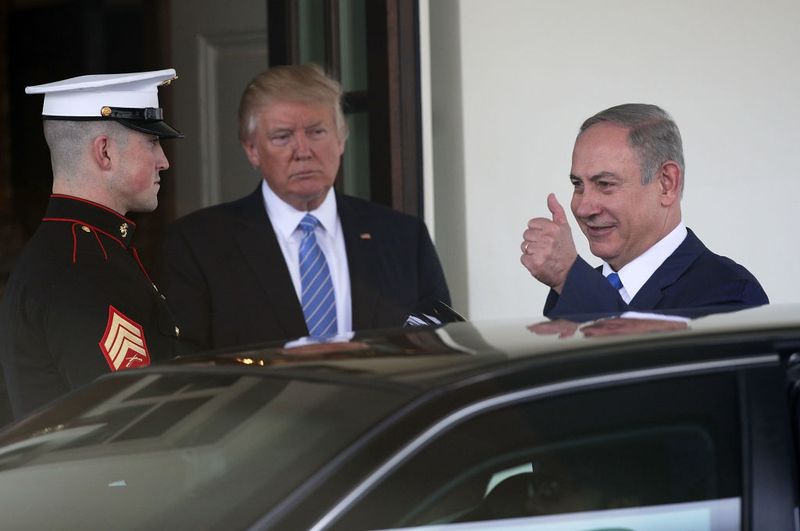One of Donald Trump’s key goals since becoming president has been to systematically reverse the policies of his predecessor. So it’s no surprise that Trump’s visit this weekend to Saudi Arabia, his first to a foreign country, will signal a break with Barack Obama’s foreign policy in the Middle East.
This is both promising and potentially troubling. On the plus side, Trump has a unique opportunity to reframe America’s engagement with the region, by addressing a set of problems ranging from Israel’s relationship with Arab nations to the Islamist radicalization that began with the Iranian revolution in 1979 and has culminated with the so-called “ISIS caliphate” in Iraq and Syria.
But there are also pitfalls to avoid, in particular how America is to confront Iranian regional ambitions and how to get back on a path to resolving the Palestinian-Israeli struggle.
That Riyadh and Jerusalem are the first stops on this trip is clearly Trump’s attempt to distance himself from Obama’s rapprochement with Iran. The previous administration’s calculation here involved creating a balance of power between the regional actors, namely Saudi and Iran, in order to diminish the US military footprint in the region. However, Obama’s strategy — as seen from the ongoing wars in Iraq, Syria and Yemen and the escalating tensions between Saudi Arabia and Iran — has failed.
Trump, in contrast, has a strong desire to side forcefully with America’s traditional allies, Saudi Arabia and Israel, and has made a point of identifying Iran as the source of instability in the region. Not incorrectly, he sees Iran as having used the cover of the nuclear agreement reached with six major powers in 2015 to increase its influence throughout the region, especially through the use of non-state actors such as “Hezbollah” in Lebanon and Syria, Houthis in Yemen and the “Popular Mobilization Units” in Iraq. In so doing, Iran has waged stealth war on Arabs by providing weapons, ideological indoctrination and training to militias across the entire region.
Trump will be fêted in Riyadh for giving primacy to America’s strategic relationship with the kingdom, and will be hailed as a partner by moderate Muslim states such as Jordan and the United Arab Emirates in the war against extremist radical movements like ISIS as well as “Hezbollah” in Lebanon.
Extremists who are equally at war with states like Saudi Arabia and Egypt, cannot be defeated without an alliance with the wider Arab world. The Saudis, for example, have warded off several al-Qaeda attacks against the homeland, and have allowed their territory to be used as a base for US attacks against al-Qaeda and ISIS. Trump will certainly acknowledge this, and is expected to give a major speech on Islam and the West. (President Trump already delivered a speech during the Riyadh Summit on Sunday)
In return, Saudi Arabia is likely to announce significant investments in infrastructure projects in America (perhaps as much as US $40 billion) and that it will be buying $100 billion or more in US arms. This will be framed as part of the kingdom’s effort to achieve two principal aims: diversifying its economy and investments, and strengthening its military capabilities and ability to protect itself instead of placing the burden on the US. Emphasis will be placed on the two countries’ historic economic and political partnership — the summit’s slogan is “Together We Prevail.”
But the meetings won’t be solely about the bilateral relationship. Another major topic will be the 70-year Arab-Israeli conflict. And thus Jerusalem will be the next stop after Riyadh.
The risk here lies in the manner in which Trump attempts to restart the Palestinian-Israeli peace negotiations.
That road map requires Israel to offer substantive near-term concessions to the Palestinians, and ultimately a viable state. In return, Israel would get full recognition and normalization of relations with the Arab nations.
For this to play out, Israel must immediately offer the Palestinians something tangible, such as permanent cessation of all settlement construction in the West Bank. If not, Iran, Assad, “Hezbollah” and the Houthis — the self-proclaimed axis of resistance to Israel and the West — will have a strong argument to the Muslim world that revanchism is the only avenue for dealing with Israel.
Another difficulty lies with how Trump will handle Iran, now that he will reposition the US squarely with Saudi Arabia. His former national security advisor, General Michael Flynn, famously put Tehran “on notice” for testing a ballistic missile. But what does this mean in practice? A direct American strike on Iran is inconceivable without an open Iranian provocation such as an attack on a US Navy ship in the Persian Gulf.
On Wednesday, it kept in place waivers of nuclear sanctions against Iran after acknowledging that Tehran was complying with the agreement’s terms. So deciding on where and how to put pressure on Iran is important.
Yemen offers the best arena to begin to roll back Iranian influence. Tehran is clearly involved in supporting and supplying weapons to the Houthi rebels, attempting to create a Hezbollah-like force that can harass Saudi Arabia across the border.
It should be possible to make the regime understand that its foray in Yemen will come at a cost, say the sinking of any ship that is found carrying weapons to the Houthis, along with new sanctions. Instead, opening up a dialog with Iran about Yemen, which would include Saudi Arabia and its allies, might start the process of de-escalation across the entire region.
Perhaps more importantly, it would also show that without America’s active engagement, the region will remain a boiling cauldron, and that Obama was wrong by adopting a hands-off policy in the Middle East. Trump should like that.
Bloomberg
